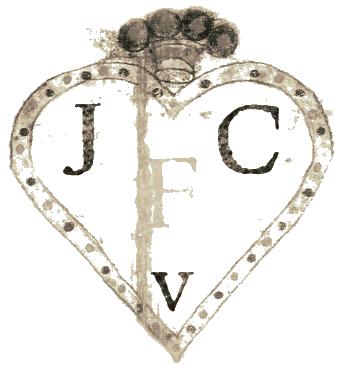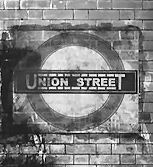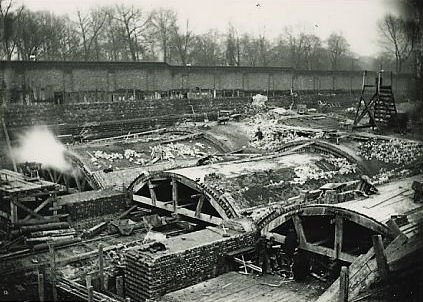

The urban myths and
murky reality of another London existing under our feet breed seductive stories.
They involve the dark, the dirty, the unknown, and the fear and
suspicion of what 'they' might be up to.
Chapman Pincher in the Daily Express in 1959 wrote of Ten miles of
reinforced tunnels built under London
after the last
war at enormous cost ... below Whitehall, Leicester Square, Holborn and Victoria.

The Buckingham Palace Tunnel
There are several rumoured escape
tunnels from Buckingham Palace. One is said to run under Green Park to
the Piccadilly Tube line, giving the royals a speedy escape route to Heathrow.
Another is said to give access to the Victoria Line - which runs under
the Palace - for a similar escape, and one is said to lead to Wellington
Barracks just over the road. More likely is the tunnel running
along the Mall to the underground citadel called Q-Whitehall which is rumoured
to stretch as far north as Holborn. Supposed evidence of this complex is
the huge extractor fan outside the Gent’s toilets in the ICA, which the
ICA say is nothing to do with them, and the fortress on the
corner of the Mall and Horse Guards Road which is said to be an entrance
to Q-Whitehall. This network, known as Pindar, connects to 10 Downing Street
via the atom-bomb-proof bunker which was built under the Ministry of Defence building
at a cost over £110 million in the early 1990s.
As the years go by Pindar becomes less of a secret, being mentioned
matter-of-factly in, for example, Andrew Rawnsley's The End of the Party.
A new (2010) edition of this book, about the death of the Labour
party, has Gordon Brown going down into the basement of 10 Downing Street,
going through a hefty door and walking tunnels to the Ministry of Defence,
on his way to a fruitless meeting with Nick Clegg after the 2010 general
election.
The Chancery Lane Tunnels
Sometimes deceptively known as the Kingsway Tunnels
(they are a fair distance from Kingsway) they were in the news in October
2008 due to BT putting them up for sale. The tunnels run under High Holborn
from just beyond Chancery Lane all the way to Leather Lane. Access is gained through an
inconspicuous goods entrance in Furnival Street - the
only one of the three original entrances, which included one in
High Holborn, that remains. The two half-mile tunnels were originally built
in 1942 as deep-level shelters. After the
war they passed to a section of MI6 called The Inter
Services Research Bureau, said to have been a branch of MI6 that helped the
resistance groups in occupied Europe.
The Public Records Office took them over on May 8th 1945 and stored
classified documents there, before the tunnels were acquired and extended by British
Telecom in 1954. They added new tunnels and housed some very secure
telephone exchanges, as well as a staff bar and restaurant which retain
their decidedly 70s orange and brown colour scheme. The restaurant
reportedly had
fake windows with views of lakes and gardens. At the time of revising this
(December 2011) BT have yet to find a buyer for the tunnels.
The Kingsway Tram
Tunnel
In 1905 the London County Council's'
Holborn-Strand improvement scheme involved massive 'slum-clearance', in the
name of which many fine streets and building were destroyed and Kingsway and
its tram subway were created. Services from the Angel to the Aldwych began
using the tunnel on the 24th January 1906. The Fleet Sewer in the north and
the District Line tunnel by the Embankment set the limits of the
tunnel, and the slope of the north entrance was so steep that drivers not
concentrating would find themselves rolling back into the Holborn tram
station. In 1929 the tunnels were enlarged to take double-height trams, but
when trolley buses were introduced a few years later the trams were slowly
phased out. The last one ran through the subway on the 5th of April 1952.
The south end was made into a traffic
underpass in 1964, but the northern section
remains abandoned and spooky, used occasionally for a film or TV
series, most recently as a fictional Underground station called Union Street
in the film The Escapist. The posters and signs on the walls down
there are said to mix the real with the fictional, what with the addition of
film-set decoration layered over real old stuff.
south end was made into a traffic
underpass in 1964, but the northern section
remains abandoned and spooky, used occasionally for a film or TV
series, most recently as a fictional Underground station called Union Street
in the film The Escapist. The posters and signs on the walls down
there are said to mix the real with the fictional, what with the addition of
film-set decoration layered over real old stuff.
The South Kensington Tunnel
Not very spooky, but a well known
tunnel used by visitors to the South Kensington museums coming from South
Kensington Underground station.
'But, why was it built?' You ask. Well the 500 yard pedestrian
tunnel
was built for visitors to exhibitions held on the site of what is now Imperial
College. After the success of the Fisheries Exhibition of 1883 and the
Health Exhibition of 1884 a tunnel was built and a toll of 1d (one old
penny) was charged. It was built to keep pedestrians away from the dangers of
Exhibition Road, the haunt of 'cab-callers, hawkers and other
objectionable characters'. There followed the Inventions Exhibition of 1885 and
the Colonial and Indian Exhibition of 1886, then the exhibitions moved
to Earls Court, leaving the Metropolitan District Railway with a tunnel
going nowhere. It was for years opened only on special occasions, and a
suggestion in 1906 that it be extended to serve the Royal Albert Hall was
rejected.
On the 21st of December 1908 it was opened permanently, free
of charge, and new exits serving the Victoria & Albert and Natural History
museums were opened in 1913. In 2006 it was granted Grade
II listed status by English Heritage.
The Tunnels under Lords
The network of railway tunnels under Lord's cricket ground has been in the
news in recent years, due to various plans for their development. One of
them still carries trains from Marylebone to Birmingham, but two
more were sold in 2008 and plans for their use have ranged from various
Lords facilities, including their museum, through an underground hospital
to a station allowing cricket fans direct access to the ground. Lords'
ownership of the ground only goes down 18 inches. Below that belongs to
the developers who bought the tunnels, and hence a dispute that's rumbled
on for a few years now. The
tunnels are currently bizarrely only accessible from the basement of the Wellington
Hospital. The photo (see below) is of the tunnels under
construction, the image belonging, oddly, to Leicestershire Council.


![]()
|
|
||
|
|
The Underground provides related
legends of bricked-up trains full of skeletons in dark and dusty suits
and of lost and miraculously preserved stations. This theme
has been covered by fiction as disparate as the 1972 film
Death Line
and an episode of The Goon Show called The Scarlet Capsule,
the mysterious 'mind-the-doors' chant being
a shared theme. More recently Whispers Under Ground, the third in Ben
Aaronovitch's witty series featuring the Met's own magic-wielding
supernatural detective Peter Grant, covers old and fresh ground underground.
It references Death Line, has big-eyed white-faced types living
underground and raising pale pigs, and brings the whole thing up to date
with tunnels being built secretly under cover of the construction of the Crossrail
project. There is supposed to be an office block in the City which has a basement room where, if you open an old door behind a filing cabinet, you find yourself on a long-disused station platform, where the chocolate machines take pre-decimal money and posters advertise long-forgotten films. Ghost stations which do exist include Down Street (see photo left). Closed in May 1932 its brick walls are visible when travelling between Hyde Park Corner and Green Park on the Piccadilly Line. (Tours of Down Street can be booked through The London Transport Museum.) Then there's Spring Grove (Piccadilly Line), Tower of London and Lords (Metropolitan), British Museum and Post Office (Central), and Bull & Bush, King William Street, City Road and South Kentish Town (Northern). There are 40 in all. In November 2011 came the news that a businessman is trying to persuade TfL to let him buy up, and put to use, 26 of these disused tube stations. The term 'ghost stations' has become de rigueur, but Ajit Chambers has set up The Old London Underground Company and is hoping, by making some of them into tourist attractions, to open more as money-making restaurants and nightclubs and such like. He takes an Evening Standard journalist down Brompton Road station, which was used as an anti-aircraft control station during WWII and was where, we are told, Rudolf Hess was interrogated. The article was preceded by a news item earlier in 2011. London's cartoon-character Mayor Boris Johnson was very enthusiastic, but let's hope that something good will come of this anyway, although, as 2014 dawns, nothing has as yet. |
|
![]()
|
Aldwych Station
Opened in 1907, Aldwych was always a bit of a runt of a station. Originally called Strand Station, it ran as a single-stop shuttle from Holborn as it was always meant to be the first stop on an extension, but this never happened. Three large lift shafts were dug in expectation of expansion, but only one ever had a lift installed. In 1917 the eastern tunnel and platform was closed and used to store paintings from the National Gallery during the war. In the next war the station was used as an air-raid shelter and to store British Museum treasures, including the Elgin Marbles. The station was closed on Friday September 30th 1994, and it now features in almost every film made in London which needs some London Underground scenes. This is due partly to its good location, and partly to its large lift, which is ideal for moving location camera gear. Old tube stock is permanently is also parked here for this purpose. If you've seen Nil by Mouth, Sliding Doors, Neil Gaiman's Neverwhere or This year's love, amongst many others, you've seen a film filmed down the Aldwych. If you've played Tomb Raider III you've played a game with some action set here (see below). Lately it's featured in the Harry Potter films, the TV series Spooks and in 2014 in the tube-centric shenanigans at the end of the first episode of season 3 of the BBC's modern-day Sherlock. 
|
Charing Cross Jubilee Line
platforms Some relatively new abandoned platforms that became disused when the Jubilee Line extension bypassed Charing Cross on its stretch from Green Park in favour of Waterloo. Since their closure in1999 the platforms have been kept maintained for use by film crews needing a more modern setting than the platforms at Aldwych. Dover Street The film Wings of the Dove featured a handsome Edwardian station called Dover Street, which is what Green Park station used to be called. The webmaster of the excellent Underground History website linked to below is of the opinion that this is a set, if an unusually accurate one, but is keen to hear from anyone with certain knowledge. The characters also travel through an authentic sequence of stations, even if the do look like the same set with different name panels! Down Street
|
|
![]()

